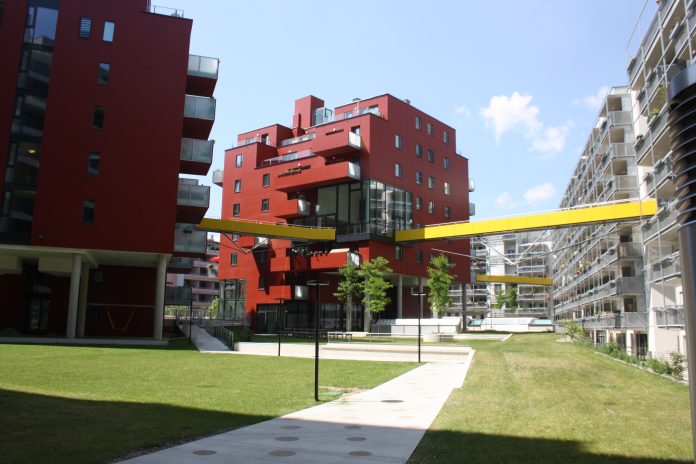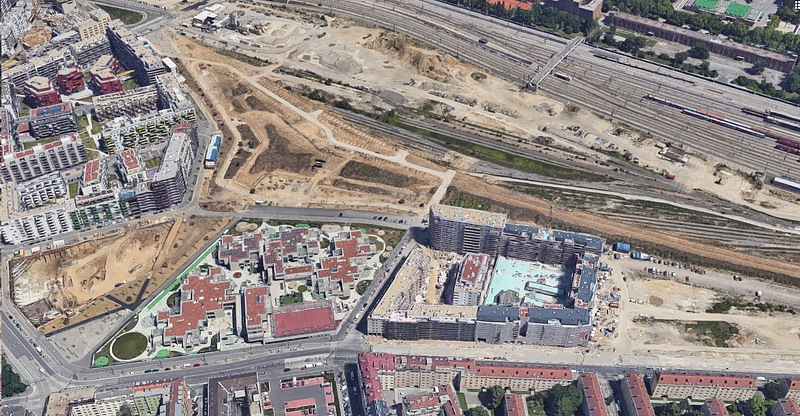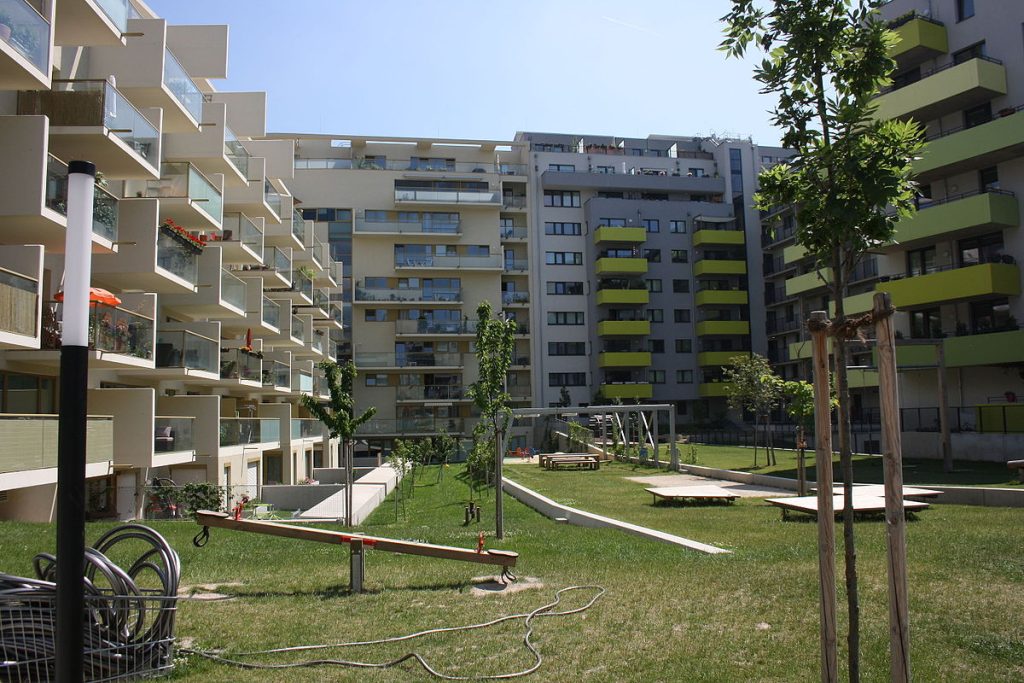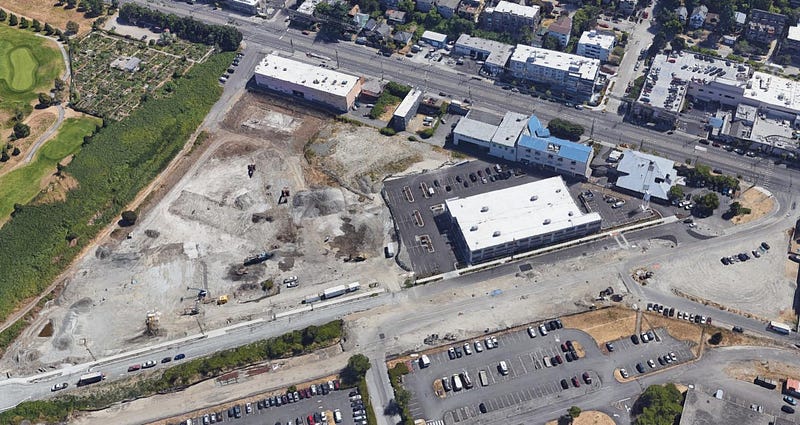
On Tuesday, My Ballard published that the state was looking for input on a nearly 25 acre parcel of land that it owns, adjacent to the BNSF railyard in Interbay. The site is presently utilized by the Washington National Guard, who will likely be relocating their armory out of the city due to traffic and other issues. This is an opportunity to seriously address the intersection of our housing and climate crises.
This parcel is going to be redeveloped. It is presently zoned IG2 U/45, which is an industrial general zoning that allows 45-foot tall buildings. IG zoning allows heavy manufacturing — but also commercial (retail/office/entertainment/R&D). As I noted for The Urbanist a few weeks ago —industrial lands were exempt from contributing to MHA. This, despite contributing to the jobs/housing imbalance, exacerbating our housing crunch.
As we should have done with Fort Lawton, this is a once in a lifetime opportunity to build a dense, car-free/car-light ecodistrict for thousands of residents with a wide range of incomes. We should do everything possible to prevent this from just becoming another corporate campus. The Interbay EcoDistrict could be a massive shift in the way we approach housing: an affordable, mass-timber, car-free, family-friendly, passivhaus district.
Challenges and Opportunities with the Armory Site

The site poses several issues. It is built on fill. It is at risk for flooding with storms and sea level rise. These could all be mitigated — mass timber buildings have passed shake tests. But it also offers immense opportunities. It sits a block off the RapidRide D line. With light rail headed to Ballard, the potential for an infill station at Interbay is highly possible. It’s a flat, 20-minute ride on the beautiful Elliott Bay Trail to Pioneer Square. Most importantly, not a single resident would be displaced for housing here.
I know what you’re thinking… Can trains and housing even co-exist? Naturlich. They coexist all over the world, quite densely, even. Yes, there are pollution issues. This could be partially mitigated by requiring all projects to meet passivhaus so there is little air leakage, and all air is filtered. That passivhaus is a buoy against energy poverty only adds to the resilience here. There are other things that can be done, like putting circulation on the train-side, as a buffer against the noise. This was the approach for a large passivhaus social housing development adjacent a railyard in Vienna.

And speaking of Vienna, the city is in process of completing a large neighborhood development of a brownfield that is similar to what could happen here, adjacent to the tracks at the main train station. The Sonnwendviertel is a new district with 5,000 homes, 40% of which are social housing. It also includes a large park, schools, kindergartens, and shops.

In Frankfurt, on a swath of land only slightly larger, the city is leading development of the Schoenhof-Viertel — a new district planned for 2,000 homes (600 affordable), with daycare facilities, a school, retail space, and a park.
If these models are successful in major European cities with a commitment to addressing climate change, perhaps instead of re-inventing the wheel, we just copy-paste what these progressive cities are already doing.
Let’s do a little math…
Twenty-five acres, with a housing density of 100 dwelling units per acre (an amount Jane Jacobs figured was likely too low for urban living) would be 2,500 units. Housing for 5000 residents (or more, if we built 3 and 4-bedroom units here). Requiring 30% of them to be social housing would net 750 units. But we can do more!
Directly north of the armory site is an ROW which could be vacated — and the Interbay Golf Course. Adding these into the ecodistrict would net 75 acres. Because of Initiative 42, we can’t just take park land and use it to develop social housing (alas). However, what we could do is run a massive park down the middle of the development that is of equivalent size, and would be available to more than a couple of golfers a day. Thirty acres at 150 dwelling units per acre would net 4,500 homes, places for nearly 9,000 people.

But we can keep going. This triangular section is roughly 12 acres — enough to yield another 1,800 units. That’s 6,300 homes. Think providing moderately dense housing for nearly 13,000 people — adjacent to a massive park, connected to transit, and highly bikeable — would be a massive improvement over a corporate campus like the one being built directly to the south? I do.
Remember how the anti-housing Seattle Times argued we should waste $400 million dollars on a redundant bridge only a few thousand people would use per day? What if that $400 million was utilized for the development of a new school campus, several hundred units of social housing, a new urban park instead… This would be a game changer for Seattle, but it isn’t anything new. This is exactly what cities like Basel, Zuerich, Vienna and Amsterdam are doing to address the housing crisis, climate crisis, all the while improving livability.
There will be several meetings over the next few months, with the Interbay Project committee providing a recommendation to Governor Jay Inslee by November 15th. The first open house on this project will be March 19th in Ballard. Housing and climate activists should show up en masse and demand a dense, affordable, climate-resilient ecodistrict.
This is a cross-post from Mike Eliason’s blog on Medium.
Mike is the founder of Larch Lab, an architecture and urbanism think and do tank focusing on prefabricated, decarbonized, climate-adaptive, low-energy urban buildings; sustainable mobility; livable ecodistricts. He is also a dad, writer, and researcher with a passion for passivhaus buildings, baugruppen, social housing, livable cities, and car-free streets. After living in Freiburg, Mike spent 15 years raising his family - nearly car-free, in Fremont. After a brief sojourn to study mass timber buildings in Bayern, he has returned to jumpstart a baugruppe movement and help build a more sustainable, equitable, and livable Seattle. Ohne autos.

